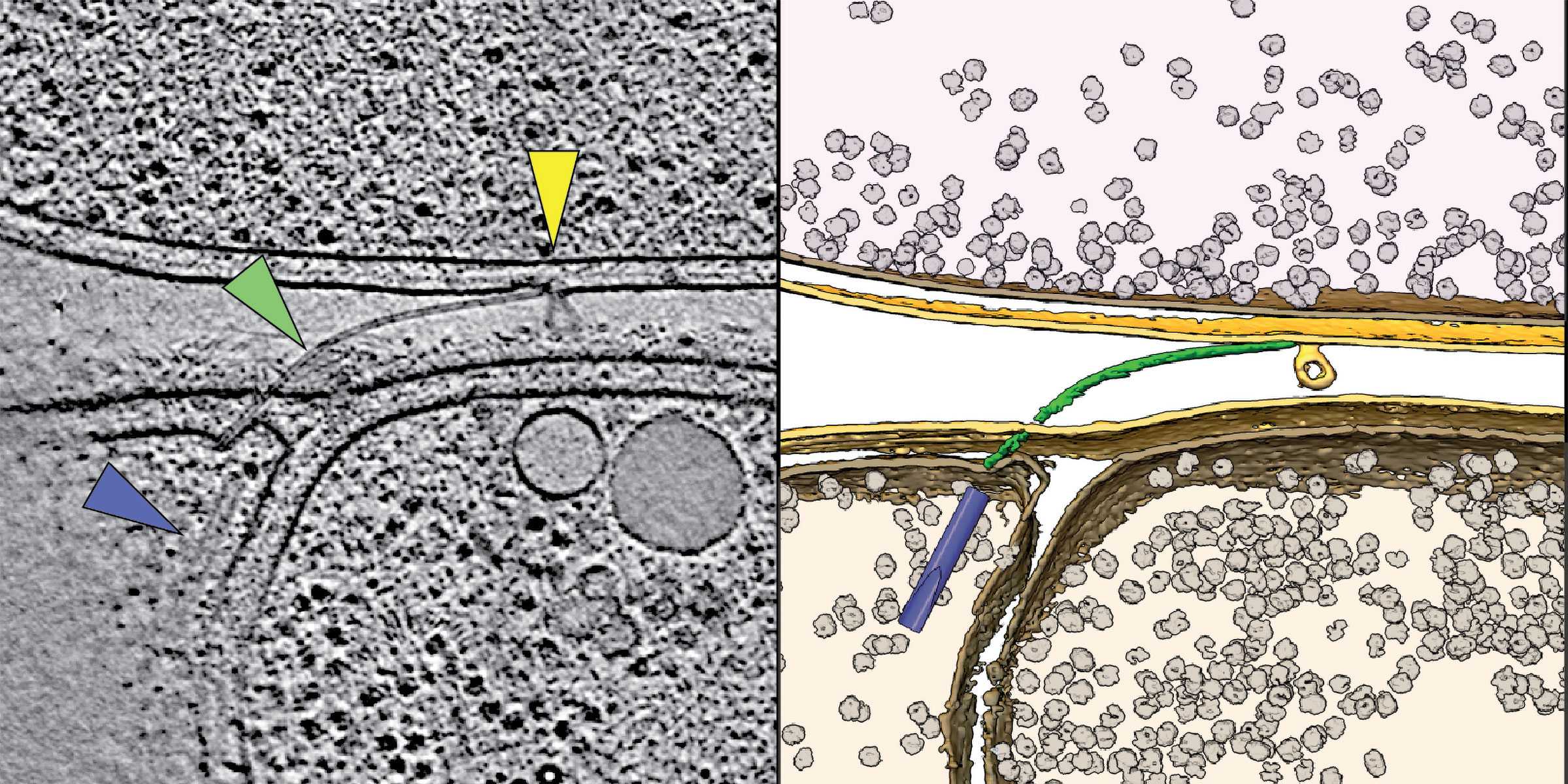Researchers at ETH Zurich have analysed down to the smallest detail the unusual arsenal of weapons that a predatory marine bacterium has at its disposal. Perhaps one day these weapons could also be put to use in medicine.

In brief
- ETH Zurich researchers are revealing the structure and function of two previously unexplored weapons of the predatory bacterium Aureispira.
- The weapons are a molecular grappling hook, which Aureispira uses to catch its prey, and a spring-loaded cannon, which it uses to kill it.
- It may be possible to use such predatory bacteria to combat blooms of algae or to deliver active ingredients to individual body cells.
Countless bacteria call the vastness of the oceans home, and they all face the same problem: the nutrients they need to grow and multiply are scarce and unevenly distributed in the waters around them. In some spots they are present in abundance, but in many places they are sorely lacking. This has led a few bacteria to develop into efficient hunters to tap into new sources of sustenance in the form of other microorganisms.
Although this strategy is very successful, researchers have so far found only a few predatory bacterial species. One is the soil bacterium Myxococcus xanthus; another is Vampirococcus, which sucks its prey dry like a vampire.
A bacterium that behaves like a pirate ship
In a new study, researchers at ETH Zurich led by Martin Pilhofer, Professor at the Department of Biology, along with his colleagues Yun-Wei Lien and Gregor Weiss, have now presented another of these rare bacterial predators: the filamentous marine bacterium Aureispira.
Among the molecular structures that the researchers have identified in Aureispira are ones that resemble grappling hooks and serve a similar purpose. The bacterium also has a kind of bolt gun that it uses to kill its prey.

Like a pirate ship in search of a potential victim, Aureispira swiftly glides over solid surfaces towards its prey, such as Vibrio bacteria. If the attacker is itself free-floating in water, it waits for its prey to approach. As soon as there is close contact, the grappling hooks become entangled with the victim's flagella, and it can no longer escape.
Within seconds, Aureispira fires its on-board cannons to punch holes in the Vibrio bacterium's membrane. In collaboration with the laboratory of ETH Professor Roman Stocker, the researchers were able to show that the cell components that leak out of the victim are quickly taken up by the predator as food. "The whole scene resembles a pirate raid on another ship," Pilhofer says with a grin.
It's only when the nutrient concentration in its environment is low that Aureispira becomes predatory. As long as the supply of nutrients is sufficient, the pirate bacterium refrains from catching prey and stands down its arsenal of weapons. However, putting the bacterium on a diet awakens its desire to hunt and causes the cell to rebuild the cannons and grappling hooks. Scientists call this selectively predatory lifestyle ixotrophy. Together with Martin Polz's group at the University of Vienna, the researchers were also able to find evidence that this predatory lifestyle does not only occur in the laboratory but actually in marine samples.

New imaging reveals details
The researchers used several imaging techniques, including light microscopy and cryo-electron microscopy, to understand the function and molecular structure of the grappling hooks and cannons.
This method made it possible to preserve and analyse molecular structures free of artefacts and in their cellular context. With an enhanced version of the method, it's even possible to determine the molecular structure of the proteins that make up the bacterium's weapons. "All of these imaging techniques are available at ETH Zurich's ScopeM competence centre, which made this study possible in the first place," Weiss says.
Combating algal blooms
What are the findings good for? "First and foremost, this is basic research driven by our curiosity," Pilhofer says. He and his colleague Weiss have been working for ten years to elucidate contractile injection systems - the name given to the pirate bacteria's on-board cannons.
In other predatory bacteria, contractile injection systems are often also loaded with toxins to kill the prey immediately. It's conceivable that such bacterial bolt guns could be loaded with active ingredients for injection into individual cells with the help of a molecular machine.
Certain predatory bacteria are known to prey on cyanobacteria, or blue-green algae. That means they could be used to combat algal blooms or to stop mass propagation of Vibrio bacteria. "These bacterial predators are very efficient at what they do," Weiss says.
Reference
Lien YW, Amendola D, Lee KS, Bartlau N, Xu J, Furusawa G, Polz MF, Stocker R, Weiss GL, Pilhofer M. Mechanism of bacterial predation via ixotrophy. Science, Oct 17th 2024. DOI: external page 10.1126/science.adp0614






